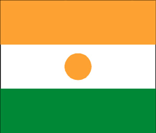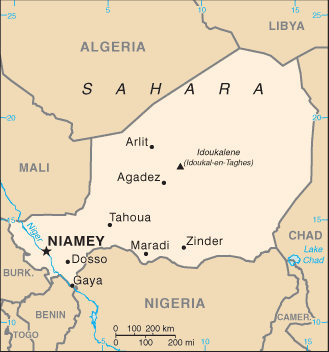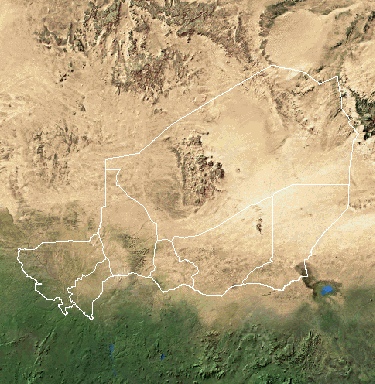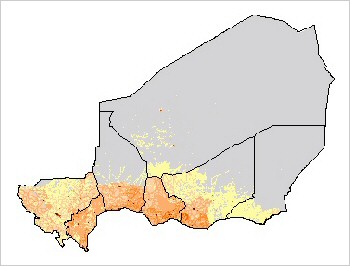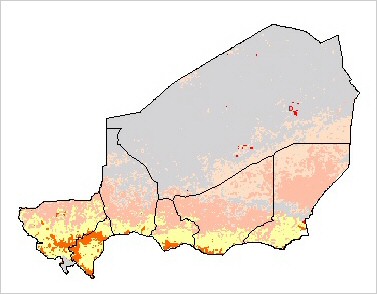|
|
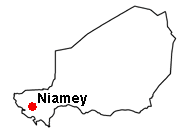 |
| back to top | |||
|
Population. Estimated at 40 to 50. Still found in the Niger Sahel running from Mali to Chad with concentrations of 10 to 15 pairs in the L'Air Tenere Reserve in the northwest central park of the country. A few remain in the Termit Area. In 2002 during a field survey in the Termit area in Niger, 48 cheetah tracks were discovered, of which 14 were from groups of two animals. 5 cheetahs have been observed. In Niger’s Park W (the entire tri-country park is over 11,000 km2 of which Nigerrquote s protion is about 2,200 km2) in the extreme south west of the country bordering Benin and Burkina Faso there are still cheetah. In a study between 1993 and 1995, 22 cheetah were seen in this park in eight sightings with an estimation of at least nine cheetahs living in the park. Small populations of cheetahs have been recorded in Reserve Naturelle Nationale de L'Air et du Tenere (20 or 30 animals) (77,360 Km2). Principal Threats . Poaching, lack of prey species, conflict with livestock. |
|||
|
|
|||
|
|||
|
Niger became independent from France in 1960 and experienced single-party and military rule until 1991, when Gen. Ali SAIBOU was forced by public pressure to allow multiparty elections, which resulted in a democratic government in 1993. Political infighting brought the government to a standstill and in 1996 led to a coup by Col. Ibrahim BARE. In 1999 BARE was killed in a coup by military officers who promptly restored democratic rule and held elections that brought Mamadou TANDJA to power in December of that year. TANDJA was reelected in 2004. Niger is one of the poorest countries in the world with minimal government services and insufficient funds to develop its resource base. The largely agrarian and subsistence-based economy is frequently disrupted by extended droughts common to the Sahel region of Africa. |
|||
| back to top | |
|
Area: total: 1.267 million sq km; land: 1,266,700 sq km; water: 300 sq km Climate: desert; mostly hot, dry, dusty; tropical in extreme south Terrain: predominately desert plains and sand dunes; flat to rolling plains in south; hills in north Natural resources: uranium, coal, iron ore, tin, phosphates, gold, petroleum Natural hazards: recurring droughts Land use: arable land: 11.43%; permanent crops: 0.01%; other: 88.56% (2005) Irrigated land: 730 sq km (2003) Environment-current issues: overgrazing; soil erosion; deforestation; desertification; wildlife populations (such as elephant, hippopotamus, giraffe, and lion) threatened because of poaching and habitat destruction Environment-international agreements:
|
|
|
|
|
|
|
|
|
|
|
| back to top | |
|
Population: 12,525,094 (July 2006 est.) Age structure: 0-14 years: 46.9% (male 2,994,022/female 2,882,273); 15-64 years: 50.7% (male 3,262,114/female 3,083,522); 65 years and over: 2.4% (male 150,982/female 152,181) (2006 est.) Median age: total: 16.5 years; male: 16.5 years; female: 16.4 years (2006 est.) Population growth rate: 2.92% (2006 est.) Infant mortality rate: total: 118.25 deaths/1,000 live births; male: 122.29 deaths/1,000 live births; female: 114.1 deaths/1,000 live births (2006 est.) Life expectancy at birth: total population: 43.76 years; male: 43.8 years; female: 43.73 years (2006 est.) Total fertility rate: 7.46 children born/woman (2006 est.) |
|
|
HIV/AIDS - adult prevalence rate: 1.2% (2003 est.) Distribution of the human population in Niger HIV/AIDS - people living with HIV/AIDS: 70,000 (2003 est.) HIV/AIDS - deaths: 4,800 (2003 est.) Ethnic groups: Hausa 56%, Djerma 22%, Fula 8.5%, Tuareg 8%, Beri Beri (Kanouri) 4.3%, Arab, Toubou, and Gourmantche 1.2%, about 1,200 French expatriates Religions: Muslim 80%, remainder indigenous beliefs and Christians Languages: French (official), Hausa, Djerma |
|
|
|
|
| back to top | |
|
Data code: NG Government type: republic Independence: 3 August 1960 (from France) Legal system: based on French civil law system and customary law; has not accepted compulsory ICJ jurisdiction |
|
|
|
|
| back to top | |
|
Economy-overview: Niger is a poor, landlocked Sub-Saharan nation, whose economy centers on subsistence agriculture, animal husbandry, reexport trade, and increasingly less on uranium, its major export since the 1970s. The 50% devaluation of the West African franc in January 1994 boosted exports of livestock, cowpeas, onions, and the products of Niger's small cotton industry. The government relies on bilateral and multilateral aid for operating expenses and public investment and is strongly induced to adhere to structural adjustment programs designed by the IMF and the World Bank. Short-term prospects depend largely on upcoming negotiations on debt relief and extended aid |
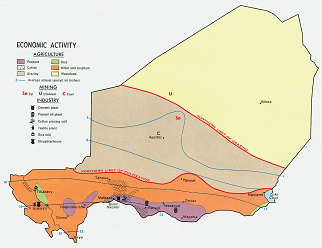 |
|
GDP - real growth rate: 3.5% (2006 est.) GDP - composition by sector: agriculture: 39%; industry: 17%; services: 44% (2001) Labor force: 70,000 salaried workers, 60% of whom are employed in the public sector (2002 est.) Labor force-by occupation: agriculture 90%, industry and commerce 6%, government 4% Unemployment rate: NA% Population below poverty line: 63% (1993 est.) Industries: cement, brick, textiles, food processing, chemicals, slaughterhouses, and a few other small light industries; uranium mining |
|
|
Industrial production growth rate: 5.1% (2003 est.) Agriculture-products: cowpeas, cotton, peanuts, millet, sorghum, cassava (tapioca), rice; cattle, sheep, goats, camels, donkeys, horses, poultry Exports: $269 million (f.o.b., 1997) Exports-commodities: uranium ore 50%, livestock products 20%, cowpeas, onions (1996 est.) Exports-partners: Greece 21%, Canada 18%, France 12%, Nigeria 7% (1996 est.) Imports: $295 million (c.i.f., 1997) Imports-commodities: consumer goods, primary materials, machinery, vehicles and parts, petroleum, cereals Imports-partners: France 17%, Cote d'Ivoire 7%, US 5%, Belgium-Luxembourg 4%, Nigeria (1996 est.) |
|
|
Currency: 1 Communaute Financiere Africaine franc (CFAF) = 100 centimes Exchange rates: Communaute Financiere Africaine francs (CFAF) per US$1-560.01 (January 1999), 589.95 (1998), 583.67 (1997), 511.55 (1996), 499.15 (1995), 555.20 (1994) |
|
|
|
|
| back to top | |
|
Telephone
system: small system of wire, radiotelephone communications,
and microwave radio relay links concentrated in southwestern area Radio broadcast stations: AM 15, FM 6, shortwave 0 Television broadcast stations: 10 (in addition, there are seven low-power repeaters) (1997) Internet country code: .ne Internet hosts: 189 (2006) Internet users: 24,000 (2005) |
|
| back to top |
|
Marker L., Malouf J. and Malouf A. 1999. Appendix 2: The status of the wild cheetah in its range countries. In: 1999 International Cheetah Studbook. Claro F. and Sissler C. 2003. Cheetahs in the Termit region in Niger. http://www.lib.utexas.edu/maps/niger.html |
